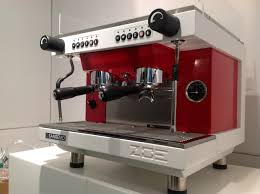Regular maintenance of commercial coffee machines is an essential practice. Neglecting these tasks could see your machine out of order with your business losing money in lost sales, not to mention the bill that could arise from costly repairs and coffee machine engineer call out fees.
All commercial coffee machines require maintenance, from daily/weekly tasks to ones that should be done after each drink, it is essential that you keep your machine running smoothly and all baristas operating the machine understand the importance of such tasks. Traditional espresso machines sold by Beanmachines and other companies, require a somewhat different maintenance procedure to Bean to Cup machines in that many of the cleaning and maintenance procedures of the latter are automatic and many machines even display prompts (to flush/clean the system etc).
At the very least follow the three golden rules of coffee machine maintenance and integrate them within your business. Trained baristas who understand these rules yet neglect to perform these simple cleaning measures clearly do not care for the work they are conducting. What does this say for the coffee that they are producing?
Rule No 1. CLEAN STEAM WAND AFTER EVERY MILK BASED DRINK.
Tip! Before you use the steam wand its good practice to purge a small amount of steam from the wand, this will prevent you getting any hot water into the milk you are about to steam/froth.
After you have finished using the steam wand you should wipe the wand with a damp cloth to prevent dried milk forming on the steam wand. Along with this you should purge the steam for a second or two to expel any milk residue that has collected in the holes at the end of the steam wand. Over time this residue can build up and cause a blockage. From a hygiene point fresh milk goes bad and can affect the quality of the drinks you are producing. In a worst case scenario the blockage could cause damage to the machine as the pressure has to go somewhere, if the holes are completely blocked then it will have to find another outlet. This is a simple procedure and should not be overlooked.
Rule No 2. BACKFLUSH THE COFFEE MACHINE DAILY
Simply put, a dirty coffee machine will produce dirty tasting coffee. Commercial coffee machines should be back flushed daily to ensure consistent cleanliness.
Different espresso machine cleaners will specify slightly different instructions but the general procedure remains the same. The practice involves inserting a blind filter into the group handle (one without any holes in it), this allows the machine to clean itself by filling the basket with water and ‘back flushing’ the system. Once you have placed the blind filter into the group handle you will need to add some form of cleaning powder/solution (whichever you are using), then you will need activate the brew cycle for a given amount of time (usually specified by the different espresso machine cleaners). This process is then repeated a few times and flushed through with clean water. This process removes the residual build up of coffee solids and oils from the valves, screens and tubes around the group head.
Top tip! You should always season the machine by making and discarding one espresso on each group after cleaning. You can use coffee ground from the previous day to prevent waste.
Rule No 3. MAKE CHANGES TO YOUR COFFEE MACHINE WATER FILTER WHEN NECESSARY.
Different geographical areas have different water qualities and will require a water filter to be attached to your commercial coffee machine to prevent breakdowns due to lime scale build up. Along with increased risk of breakdowns, bad water will cause bad tasting coffee. As a coffee is made largely of water, poor water quality will have a dramatic affect on taste.
Different filters need to be changed at varied intervals. Generally we advise roughly every 6 months however all filters will need replacing once they have reached a usage limit (this can be monitored by the use of a water meter). Once the system is in place the price for a replacement cartridge is roughly half the price of the initial outlay.
Failure to change filters or install one initially will cause repercussions further down the line. It’s much better to make a small financial outlay initially then be hit with a large repair bit at a later date.
By following the 3 golden rules to commercial coffee machine maintenance you will be well on your way to producing consistently good quality coffee, day after day (however many other factors influence this – type of machine, coffee beans, grinder settings etc..). You should never underestimate the importance of maintenance. It will save you a massive headache and a big hole in your wallet!







Recent Comments